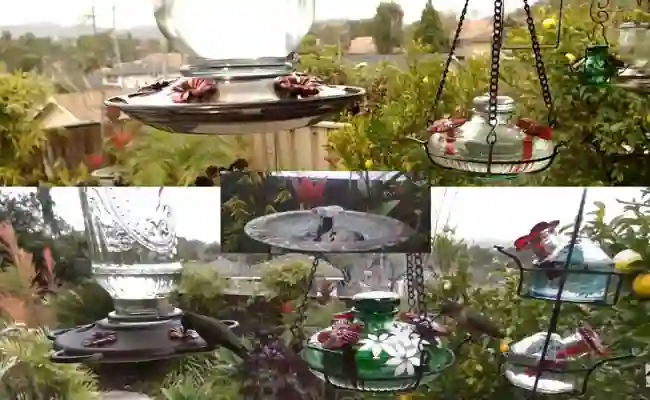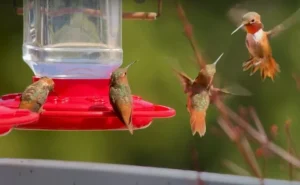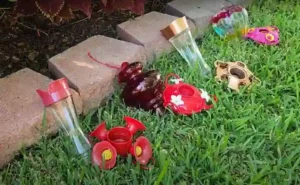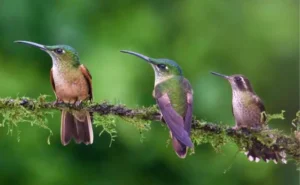Easily accessible feeding spots always attract and enhance the return rate of living things. Knowing how to detect the right spot is crucial. Are you having difficulty finding the right place(spot) to hang feeders for lovely birds in your yard? Let’s try to dig down all the pinpoints where feeders could be placed for hummingbirds.
You have arranged a hummingbird feeder. Now it’s time to decide where to hang it. A hummingbird feeder is an invitation to the colorful, super-fast flyers in your yard. You love to see those jewels hover around the feeder. Setting up hummingbird feeders is like creating a little haven for those amazing tiny birds. But to attract hummingbirds, the location of feeders plays a crucial role.
Feeder Placement Matters
Experienced birders understand that the placement of feeders has a great influence on attracting hummingbirds. Even if the feeders are just a few feet apart, moving them might affect the attraction of hummingbirds.
Setting it in the wrong place can cause leakage, attract bugs & pests, nectar spill off and predators attack hummingbirds. Putting strategically in an optimal location serves to attract a greater number of hummingbirds. It provides a secure and sheltered environment for these creatures and entertainment for you and your birds.
Placement Ensures Hummingbirds to Come to a Feeder
I used to travel to different states and as a bird enthusiast, I took my hummingbird feeder along with me. I put it in my little yard wherever I had stayed hoping to attract hummingbirds within an hour. But it took time to see my tiny friends finding their nectar feeder.
I realized that setting a feeder for hummingbirds is a great responsibility. Keep in mind that feeders should be mold and harmful bacteria-free. I observed hummingbirds that they like fresh nectar properly prepared one unit of sugar to 4 units of water.
The best thing you can do to desire more hummingbirds in your yard is to plant native hummingbird-friendly plants. In the absence of a large yard and many flower plants, you can have potted plants that work well too.
There are many things to consider when deciding where to hang hummingbird feeders. An ideal location will offer birds nearby cover and protection.
Tips for the Hummingbird Feeder Placement
Visible to hummingbirds
The first and foremost thing that you need to keep in mind while placing a feeder is that it should be visible to hummingbirds as they fly through your garden. Although the birds have keen eyesight, they are so tiny and fly so fast that sometimes feeders can be overlooked.
Thick canopies can hide feeders. So, always hang them in places that are easy to locate for hummingbirds. These safe and ideal spots for your hummers can be, near a porch, deck, patio, or a window overlooking the yard.
Hummingbirds love bright colors, particularly red, orange, and pink. You can choose feeders in these colors or hang red ribbons nearby.
Away from direct sunlight
Direct sunlight is bad for feeders it can quickly spoil the nectar on hot days and will be harmful for hummingbirds to drink from that feeder. Direct sunlight will speed up the fermentation of nectar. When the feeder is exposed to direct sunlight for an extended period, the nectar can spill out of the feeder, and it will surely attract the ants, wasps, and bees.
Larger hummingbird feeders should be positioned in shaded areas to lengthen the lifespan of the nectar. Shade helps preserve the nectar and provides a better environment for hummingbirds. Partial shade keeps nectar cold and fresh, while early light heats it, making it more enticing to birds.
Accessibility for cleaning and refilling
It is vital to keep the feeders clean and always provide fresh nectar and mold-free in the feeder. It will attract hummingbirds. Sometimes, birders place feeders in very high positions that are not very accessible to them, which makes it difficult for them to refill the feeder again and clean it.
Make sure to place the feeders in places that are easily accessible to you. It will allow you to clean and refill the feeder conveniently, ensuring good feeder hygiene and fresh nectar.
A place where you can see the feeder
It is a really fun and enjoyable moment for birders to watch little hummingbirds fly back and forth near the feeder. Place the feeder anywhere where you can enjoy the hummingbirds’ vibrant colors and intricate movements. Windows and patios can be great places where you can hang feeders and enjoy the view at the same time.
You can use window feeders for this. Window feeders are bird feeders that can be mounted on windows using suction cups. They are designed to allow birders to enjoy the view of hummingbirds up close while they feed.
Close to trees, shrubs, or a Safe place
The hummingbirds are reluctant to stay in the open when they are not feeding. They need some spots to get some rest. Hummingbird feeders should be placed near trees, shrubs, or any hiding place to give the birds a place to rest and stay out of danger.
The same, I felt in May 2017, on a holiday morning, when I was out in the garden to be pleased with nature birds, and worried to see that there were no birds at visible spots. As I moved forward and came beneath the shady trees, I was astonished to see that hummingbirds were resting in trees’ canopies.
By providing cover near hummingbird feeders, you not only attract these beautiful birds but also help them to thrive in your backyard environment.
- It’s essential to ensure that there is enough space directly around the feeder for the birds to maneuver. The feeder should be within 10 to 15 feet of a protective cover.
- You can also add some perches for hummingbirds, or you can purchase a hummingbird feeder with built-in perches.
Place multiple hummingbird feeders at a distance
Hummingbirds are very protective of their food sources and will usually chase away other birds that come to their feeder. Putting more than one hummingbird feeder far apart is best to keep the birds from fighting over these feeders.
This might make the birds less angry, so more of them have access to their food without feeling threatened. Choose feeders with multiple feeding ports to accommodate several birds at once. Place feeders in areas protected from wind and rain, with shade during the hottest part of the day.
Near flowers
Hummingbirds are always looking for flowers of bright colors to locate food sources. If your feeders are attracting a few hummingbirds, then consider placing the feeders near the flowers in your backyard. If you do not have any flowers in your garden, then planting nectar-rich flowers with red, orange, or yellow blooms close to hummingbird feeders can attract hummingbirds.
At height to protect them from cats and other predators
It is recommended to place hummingbird feeders at a reasonable height because predators, such as cats, can easily access them. Hummingbird feeders should be positioned at a height to protect the birds from predators.
You can hang the feeder approximately 5 to 6 feet above the ground. This height makes it more difficult for most ground-based predators to reach the feeder, offering a sense of security and safety for the hummingbirds.
A place to protect from winds
You must consider placing hummingbird feeders in the shelter to protect them from winds because strong winds can cause the nectar to leak from the feeder. This not only wastes food for the hummingbirds but also makes the area around the feeder sticky and attracts unwanted guests like ants and bees. Ants can pollute the nectar, which can be unsafe for hummingbirds.
- They feel more comfortable and spend more time feeding in sheltered areas where they don’t have to fight against the wind.
- A well-placed feeder with a decorative shelter can enhance the look of your garden or patio.
Quiet and Peaceful Place
Hummingbirds are tiny and delicate birds that get scared easily. They won’t eat if they think someone is close by, so it’s essential to hang their feeder in a quiet place where you don’t go often. Hummingbirds like places that are quiet and don’t move around a lot.
They might come back even if they fly away, but if they are really scared, they might not want to taste the nectar from feeders in your garden. So, it’s best to keep their feeding spot peaceful and quiet.
Near Perching Spots
The hummingbirds have high metabolisms and need to rest frequently, often visiting feeders every 10-15 minutes. If the hummingbird feeders have perching spots near them, then it’s the ideal place for hummers to enjoy. Having nearby perches allows them to take short breaks between feeds.
Hummingbirds, in their natural habitat, spend a significant amount of time perching on branches and twigs. Placing feeders near such spots allows them to exhibit their natural behavior more readily. Perching spots can create a safe, comfortable, and enriching environment for these amazing creatures.
When to take down hummingbird feeders in Idaho
Bird watchers in Idaho set up feeders in late April and early May ( the arrival time of Rufous, Calliope, and Black-chinned) to welcome them. They remove feeders from late September to early October watching the local hummingbird activity.
Hummingbirds’ migration depends not on putting feeders too long but bases on daylight changes and other natural cues. it’s important to maintain feeder cleanliness and nectar freshness for bird safety.
Pro Tip
Hummingbirds like fresh nectar made with white sugar and plain water mix. Avoid honey and brown sugar mix and commercial mixture. Prepare fresh nectar. If hummingbirds found the nectar stale, they leave the place and visit somewhere else.
Conclusion
When putting out hummingbird feeders, it’s essential to think carefully about where to place them. Hummingbirds are tiny and fast, so choose spots where they can easily see the feeders. There are some of the essential factors that play an important role in the placement of feeders.
By following these suggestions, you can create an inviting and protected environment for these little creatures to frequent your feeders, allowing you to feel closer to nature and making your outdoors more colorful and lively.
FAQs
Where should you not hang a hummingbird feeder?
Hanging a hummer feeder in full sunlight, close to the ground, or in windy places without any cover is not recommended.
How long does it take for hummingbirds to come to the feeder?
Hummingbirds may come to the feeder in a few days, but it could take them up to a week to figure it out and start coming every day.
Can I hang a hummingbird feeder in a tree?
No, it is not a good idea. To protect hummingbirds, feeders should be put in high places that are easy to see and not hidden by plants. Hang it at least 10 to 15 feet away from a tree.
Can you put a hummingbird feeder next to a bird feeder?
It is better to keep them away from each other because hummingbirds are territorial and may scare off other birds.




